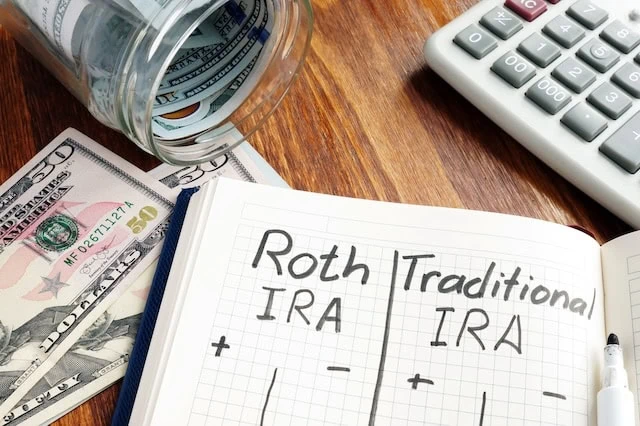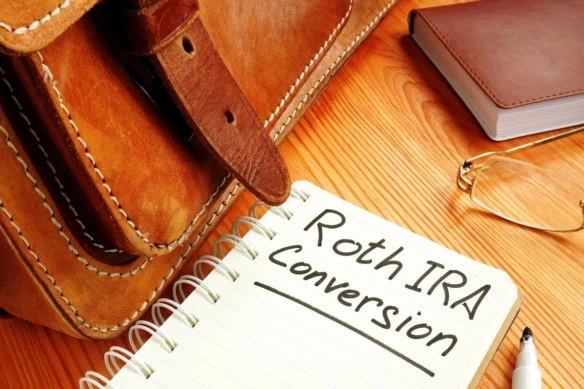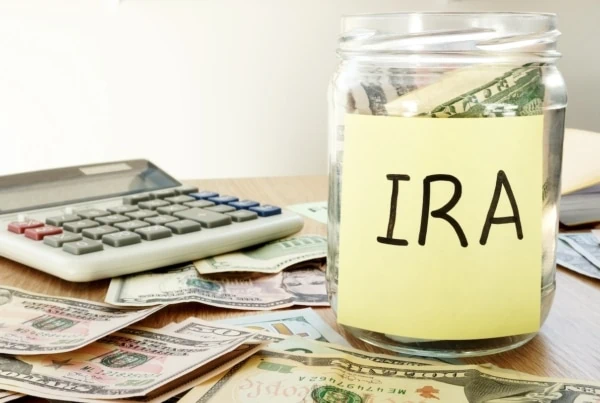Saving for retirement isn’t just about throwing money into a hole and hoping it will grow. You have to nurture that money with prudent decisions, too, such as building a portfolio that aligns with your goals, selecting smart investments … and making choices with tax-efficacy in mind.
Often, though, many people don’t consider tax consequences until later in their saving lifecycle. Then one day, they wake up to discover that they’ve stashed all of their money across tax-deferred accounts, but that having at least some of those funds tucked away in a tax-exempt accounts would be enormously beneficial for one reason or another.
Those people might benefit from a Roth conversion—where you roll over funds from a pretax account like a 401(k) or IRA into a Roth IRA (or a Roth 401(k), in a few situations). They might—but they might not. It depends on a number of factors, chief among them their current and expected future tax brackets.
Today, I’ll explain why tax brackets are a vital consideration when mulling a Roth conversion, and which tax brackets would benefit most from this retirement-account switcheroo.
Tax-Deferred vs. After-Tax Retirement Accounts

Whenever we talk about “retirement” accounts, we’re typically referring to any investment account that sports one of two tax advantages:
Tax-deferred: Contributions are made with pre-tax money, and investments grow tax-free in the account. Taxes are only taken out upon withdrawal.
After-tax: Contributions are made with money that has already been taxed. However, investments grow tax-free in the account, and generally are not taxed when taken out once you reach age 59½.
Tax-Deferred Accounts
Most retirement accounts you’ll come across are tax-deferred. This group includes:
- Traditional 401(k)s
- Traditional individual retirement accounts (IRAs)
- SIMPLE 401(k)s
- SIMPLE IRAs
- SEP IRAS
- 403(b)s
- 457(b)s
- Thrift Savings Plans (TSPs)
Because of how tax-deferred accounts work, you avoid paying taxes during the years you contribute—typically your highest-earning years, and thus years during which you end up paying the highest tax rates.
Instead, you only pay taxes once you withdraw it, which will virtually always be once you’ve reached retirement. Once you’re retired, and your income is devired from Social Security, retirement plans, and other nonwork sources, you’ll likely be in a lower tax bracket than during your working years.
After-Tax Accounts
You don’t have as wide a choice in after-tax accounts, however. Among the ones you’re most likely to see are:
- Roth IRAs
- Roth 401(k)s
- Roth 403(b)s
- Roth 457(b)s
These accounts effectively work the opposite of traditional retirement accounts in that your contributions are taxed during your working years, but withdrawals are generally tax-free. It’s generally advised to contribute to a Roth account during low-earning years (typically when you’re younger) to minimize the upfront tax hit.
Roths also work differently in that withdrawals of contributions and earnings are treated differently. You can withdraw contributions at any time without penalty or taxes. However, you only avoid taxes and penalties on withdrawals of earnings if you’re at least 59½ years old and made your first contribution at least five years ago. If you’re under age 59½ but made your first contribution at least five years ago, earnings withdrawals will be taxed, but not penalized.
Young and the Invested Tip: The five-year rule for IRAs starts at the beginning of the tax year of your first contribution to a Roth account. For instance, if you contributed to a Roth IRA on April 4, 2026, the five-year clock would begin as of Jan. 1, 2026.
One other big difference between traditional and Roth accounts? Required minimum distributions (RMD). Accounts like traditional 401(k)s and IRAs generally mandate that you begin taking a certain minimum withdrawal annually starting the year you turn 73.
Roth accounts, however, do not have RMDs.
Do you want to get serious about saving and planning for retirement? Sign up for Retire With Riley, Young and the Invested’s free retirement planning newsletter.
Roth IRA Income Limits

Not everybody is eligible to open and fund a Roth IRA—there are income limitations. For 2025, you can’t contribute to a Roth IRA if your modified adjusted gross income (MAGI) is or exceeds the following:
- $165,000 if you file single or head of household on your tax return
- $246,000 if you’re married and file jointly
However, even if you can contribute to an account, you might not be permitted to max it out. For 2025, the maximum amount a person can contribute is gradually reduced to zero if your MAGI is the following:
- $150,000 to under $165,000 if you file single or head of household
- $236,000 to under $246,000 for joint filers
If you’re married and file a separate tax return from your spouse, your maximum is gradually reduced to nothing if your MAGI is between $0 and less than $10,000.
If you make more than the limitations, you aren’t fully out of luck, however. You could still execute a Roth conversion.
Related: What Is a Backdoor Roth Conversion? [Retirement Strategy for High-Earners]
Advantages + Disadvantages of Roth Conversions

In a Roth conversion, you take assets from a tax-deferred account and move them into a tax-exempt account.
The upsides? Roth conversions allow you to avoid RMDs and take tax-free withdrawals during retirement. Plus, if you still have savings in another tax-deferred account, it diversifies your tax treatment.
But there are cons too. You’ll face tax consequences in the year of the conversion and you’re giving up your upfront tax break. You also can’t withdraw any converted money (both earnings and contributions) for at least five years. Finally, this isn’t a move for the indecisive because, if you change your mind, you can’t undo a Roth conversion.
Related: Dynasty Trusts: A Beginner’s Guide to Passing Down Wealth
So, What’s the Best Tax Bracket for Roth Conversions?

Here are the federal tax rates for 2025:
- 10%
- 12%
- 22%
- 24%
- 32%
- 35%
- 37%
In short: The lower your tax bracket, the less the upfront tax hit you’ll take from a Roth conversion, and thus the more financial sense it makes. If you’re in the 10% or 12% tax brackets, there’s a very good chance a Roth conversion is a wise option for you. If your rate is 22% or 24%, there’s still a decent chance you’d benefit from a conversion. If your rate is in the 30s, you’ll be taking a significant tax hit—though in some circumstances, it might still make sense.
That’s because as you determine whether a Roth conversion is a savvy choice, your current tax rate shouldn’t be your only consideration.
For instance, your expected tax bracket in retirement matters, too. If you think your tax bracket will be higher in retirement than where it is now, a Roth conversion ensures you’ll pay a lower rate up front instead of that higher rate on your traditional account’s withdrawals in retirement. It’s less beneficial if you expect to be in a low tax bracket as a retiree.
And as far as tax brackets are concerned, remember: If you do a Roth conversion, any converted money will qualify as income and drive you into a higher bracket. So if you’re in, say, a 10% tax bracket, a Roth conversion could be taxed at higher rates depending on whether it’s enough income to push you into a new bracket.
Also, tax brackets aren’t the only factor you need to weigh. You’ll also want to consider …
- Tax diversification
- How a conversion might benefit your heirs
- How far away you are from retirement
- If you’re currently receiving Social Security or Medicare
- Whether you have the funds to pay the conversion tax
- Whether you plan to make a significant Qualified Charitable Donation (QCD) from a traditional IRA
- Market conditions (conversions are popular during bear markets, for instance)
How Certain Considerations Can Change the General Wisdom

Like I mentioned above, a Roth conversion might initially seem unfavorable because of the immediate tax implications for the account holder, but other considerations might change the calculus.
For instance, when viewed through a multigenerational lens, the benefits of tax-free growth and required minimum distributions could outweigh the initial costs.
Here’s an example. Let’s say your taxable income would fall into the 22% or 24% marginal federal income tax bracket. The money you convert pushes your income higher, subjecting more of it to a higher tax rate now … which, on its own, could lead you to avoid making the conversion.
However, you might think differently if you had an adult child with a high-paying job who was in a high tax bracket, and you knew you would be leaving much of your retirement funds to them. In that event, they would have to distribute the account fully within 10 years of your death to comply with distribution rules, and if you passed along a tax-deferred account, that money would be taxed at an extremely high rate. But if you executed a Roth conversion, while they’d still have to withdraw it all within 10 years, the money wouldn’t be taxed at all.
In other words, despite you being in a high tax bracket currently, converting to a Roth IRA would still make sense because of your specific circumstances.
Everyone’s specific circumstances are different, of course, so it’s worth your time to talk to a financial advisor about your next moves.
Want to talk more about your financial goals or concerns? Our services include comprehensive financial planning, investment management, estate planning, taxes, and more! Schedule a call with Riley to discuss what you need, and what we can do for you.









